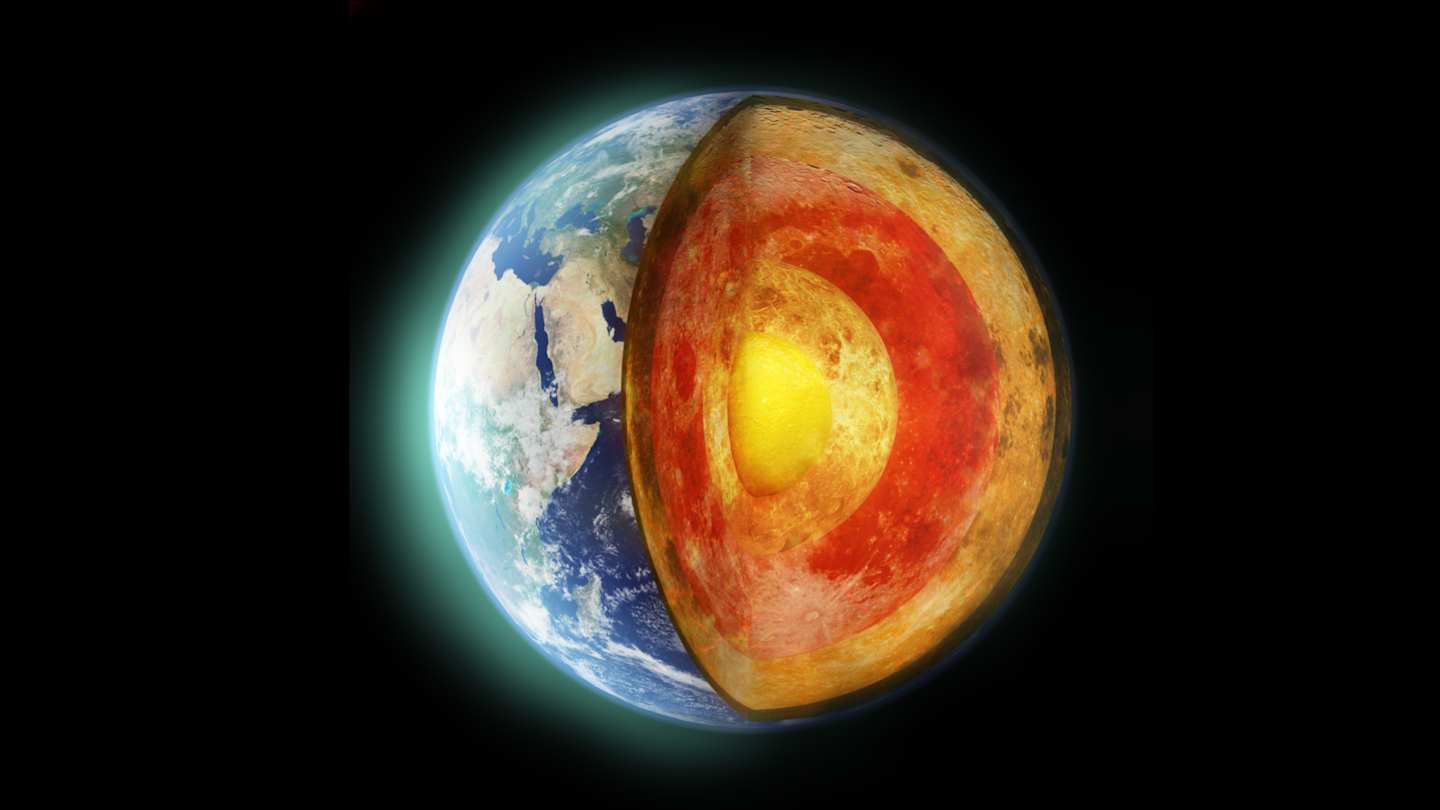Our planet Earth is a fascinating place, full of mysteries waiting to be uncovered. But did you know that beneath our feet lies a complex and dynamic structure? Earth’s interior is divided into four Distinct Layers: the crust, mantle, Outer Core, and inner core, each with unique characteristics and properties.
Let’s begin our journey by exploring These Layers, starting with the outermost one – the Thinnest Layer of all. This thin shell, known as the crust, is what we stand on and interact with every day. It might seem solid and unchanging, but it’s actually a dynamic and active region, constantly shifting and reshaping itself through Tectonic Activity.
The crust varies in thickness depending on its location, Averaging About 19 miles thick on land and a mere 3 miles under the ocean. In some places, Like Mountain Ranges, the crust can be up to 50 miles thick! Despite its thinness compared to the Other Layers, the crust plays a vital role in supporting life and shaping the Landscapes We See Around Us.
Earth’s Layered Structure
Moving deeper into Earth’s interior, we encounter the mantle, a vast and incredibly hot layer that makes up the majority of Our Planet’s volume. The mantle is about 1800 miles thick and composed primarily of Solid Rock, mainly silicon-Oxygen Compounds Called Silicates. Think of it as a giant, slow-moving ocean of molten rock – Though It’s so hot that the rock behaves more like a very viscous fluid Over Long Periods. Temperatures within the mantle range from scorching 1830°F to almost 6700°F!
Beneath the mantle lies another layer, the outer core. This layer is about 1370 miles thick and is primarily composed of liquid nickel and iron. It’s constantly churning and swirling due to Earth’s rotation and heat from the inner core. The movement of these molten metals generates electric currents that create our planet’S Magnetic Field – a protective shield that deflects harmful Solar Radiation.
 House Riddle: Einsteins Famous Puzzle Challenge
House Riddle: Einsteins Famous Puzzle ChallengeFinally, at the very center of Earth, lies the inner core, a solid sphere of iron (and other elements) with a radius of nearly 760 miles. This innermost layer experiences unimaginable pressures and temperatures, Reaching Over 9300°F! The intense pressure keeps the iron From Melting, despite the extreme heat. Imagine being squeezed so tightly that Even Your Metal Would Stay solid!
The Thin and Diverse Crust
While the crust is Earth’s Thinnest Layer, it’s incredibly diverse and plays a crucial role in shaping our planet’s surface. The crust isn’T Uniform; it’s divided into two main types: oceanic crust and Continental crust. Oceanic crust, found beneath the oceans, is thinner and denser, primarily composed of dark-Colored Basalt Rock. Continental crust, making up the continents, is thicker and less dense, with a composition that includes granite and other lighter-Colored Rocks.
This difference in density explains why continents are typically located on higher Ground Than Ocean Floors. The continental crust “floats” atop the denser oceanic crust, much like an iceberg. The crust’s diversity isn’T Limited To Its Composition; it also varies greatly in age. Some areas of the crust are millions of years old, while others are relatively young, formed through volcanic activity or tectonic uplift.
This constant interplay between different types of crust and geological processes is what creates the incredible variety of landscapes we see around the world – from towering mountains to vast plains, active volcanoes to deep ocean trenches. The crust is a dynamic and ever-Changing Layer, constantly being reshaped by the forces Within Our Planet.
Delving into the Mantle
Beneath the thin and diverse crust lies Earth’s mantle, a vast region that makes up the majority of our planet’s volume. Imagine it as a giant, hidden ocean of hot rock – though so hot that the rock behaves more like a very viscous Fluid Over Long Periods. This immense layer is about 1800 miles thick and composed mainly of Solid Rock, primarily silicon-Oxygen Compounds Known As Silicates. The mantle plays a crucial role in Earth’s Internal Dynamics, driving plate tectonics and influencing volcanic activity.
The temperature within the mantle increases dramatically with depth, Ranging From Scorching 1830°F to nearly 6700°F near its boundary with the core. This incredible heat is generated by the planet’s radioactive decay and residual heat from Its Formation. The movement of hot rock within the mantle creates convection currents, which transfer heat upwards towards the crust. These currents are responsible for the slow but continuous motion of tectonic plates – the giant slabs of the Earth’s crust that interact to create earthquakes, Volcanic Eruptions, and mountain ranges.
Delving deeper into the mantle, we encounter different zones with varying compositions and properties. The upper mantle is relatively rigid and brittle, while the lower mantle becomes increasingly dense and ductile as temperatures rise. At the boundary between the mantle and the outer core lies a thin layer known as the D” layer, where the rock undergoes a transition From Solid To Partially Molten. This region plays a crucial role in facilitating the flow of material between the mantle and the outer core, influencing both Earth’s magnetic field and its internal structure.
Liquid Iron in the Outer Core
Beneath the mantle lies the outer core, a vast layer of liquid iron and nickel that extends about 1400 Miles Deep. Imagine a churning sea of molten metal, constantly swirling and flowing due to the intense heat within Earth. This dynamic environment is crucial for Generating Our Planet’s Magnetic Field, which acts as a protective shield Against Harmful Solar Radiation.
The temperature in the outer core is estimated to be between 4,500°F and 9,000°F – hot enough to melt even the strongest metals! The constant movement of liquid iron within the outer core creates electric currents that generate magnetic fields. These fields interact with each other and with Earth’s rotation, producing a complex global magnetic field that surrounds our planet.
This magnetic field deflects charged particles from the sun, preventing them from stripping away our atmosphere and exposing us to harmful radiation. It also plays a vital role in navigation, protecting our technology from electromagnetic interference, and guiding migrating animals. Without the liquid iron churning in Earth’S Outer Core, life as we know it simply wouldn’t exist!
The Unfathomable Inner Core
Journey to the heart of our planet, and you’ll encounter the inner core – a sphere of solid iron and Nickel About 750 Miles Across. Despite being buried thousands of miles beneath the surface, this incredibly dense region exerts immense pressure, estimated to be over three million times that at sea level!
Although it’s surrounded by liquid metal in the outer core, the intense heat and pressure within the inner core cause its iron and nickel atoms to bond tightly together, forming a solid state. Temperatures here are believed to reach a staggering 9,000°F – hotter than the surface of the sun! Imagine a world where temperatures are so extreme that even metals solidify Under Immense Pressure.
Despite its inaccessibility, scientists have been able to glean fascinating insights about the inner core through seismic waves generated by earthquakes. These waves travel through Earth at different speeds depending on the density and composition of the materials they Pass Through. By analyzing these wave patterns, researchers have pieced together a remarkable picture of this enigmatic region – Revealing Clues About Its Size, composition, and even its potential rotation.










